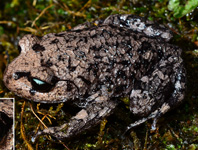Abstract
The genus Habrobathynella Schminke, 1973, comprises 14 species: two from Madagascar and 12 from the peninsular India. Two more new hyporheic species of this genus, viz. H. muvattupuzha n. sp. and H. adishankara n. sp., from the southwestern peninsular India, are described and illustrated, and their position in the genus is discussed. Both new species are more closely related to each other than to their hitherto known congeners. H. muvattupuzha n. sp. has a unique combination of characters: male Th VIII small in size, with protopod distinctly expanded latero-externally, and basipod balloon-shaped; uropodal sympod with inhomonomous row of five spines, with penultimate spine longer and thicker than others, and ultimate spine same as proximal spines; paragnaths with minaret-like smooth coupler and short lateral lobes; fifth antennular segment with only two long aesthetascs; and first maxillary segment with two setae. H. adishankara n. sp. is distinct from its congeners in having a unique set of characters: uropodal sympod with inhomonomous row of six spines, with penultimate and ultimate spines as in the preceding species; paragnaths with thumb-like, smooth coupler and small lateral lobes; first antennary segment nearly as long as the second one; fifth antennular segment with three long aesthetascs; and first maxillary segment with one seta. The principal morphological characters and their states among the Habrobathynella species, with special reference to the new species, are briefly discussed. Also, brief notes on the ecology and biogeography are given, as is an updated key to Habrobathynella species.
References
Briggs, J.C. (1989) The historical biogeography of India: isolation or contact? Systematic Zoology, 38, 322–332.
http://dx.doi.org/10.2307/2992398Delamare Deboutteville, C. & Serban, E. (1974) Contribution la connaissance des péréiopodes VIII mâles des Habrobathynella milloti (Delamare et Paulian) Parabathynellidae, Bathynellacea. Annales de Spéléologie, 29 (3), 381–387.
Mani, M.S. (1974) XXIV. Biogeographical Evolution in India. In: Mani. M.S. (Ed.), Ecology and Biogeography in India. W. Junk, The Hague, pp. 698–727.
http://dx.doi.org/10.1007/978-94-010-2331-3_24Ranga Reddy, Y. (2011) Gondwanan heritage in groundwater crustaceans of peninsular India. Current Science, 101, 156–158.
Ranga Reddy, Y. (2014) On the little-known hyporheic biodiversity of India, with annotated checklist of copepods and bathynellaceans (Crustacea) and a note on the disastrous implications of indiscriminate sand mining. Journal of Threatened Taxa, 6, 5315–5326.
http://dx.doi.org/10.11609/JoTT.o3734.5315-26Ranga Reddy, Y. & Totakura, V.R. (2010) A taxonomic revision of the genus Habrobathynella Schminke, 1973, with the description of four new species from southeastern India (Crustacea, Malacostraca, Bathynellacea). Zootaxa, 2532, 1–54.
Ranga Reddy, Y., Shaik, S. & Totakura, V.R. (2014) Habrobathynella borraensis n. sp. (Syncarida: Bathynellacea: Parabathynellidae) from the Borra Caves of southeastern India, with a note on the taxonomic significance of paragnath morphology. Journal of Crustacean Biology, 34 (1), 90–106.
http://dx.doi.org.10.1163/1937240X-00002210Ranga Reddy, Y., Shaik, S. & Totakura, V.R. (2015) Camachobathynella meghalayaensis n. g., n. sp. The first palearctic element of Bathynellacea (Eumalacostraca, Bathynellidae) from northeastern India. Journal of Crustacean Biology 35 (5), 700–713.
http://dx.doi.org/10.1163/1937240X-00002355Raval, U. & Veeraswamy, K. (2003) India-Madagascar separation: breakup along a pre-existing mobile belt and chipping of the craton. Gondwana Research, 6, 467–485.
http://dx.doi.org/10.1016/S1342-937X(05)70999-0
Schminke, H.K. (1973) Evolution, System und Verbreitungsgeschichte der Familie Parabathynellidae (Bathynellacea, Malacostraca). Akademie der Wissenschaften und der Literatur Mainz, mathematisch-naturwissenschaftliche Klasse, Mikrofauna Meeresboden, 24, 1–192.
Schminke, H.K. (1976) Systematische Untersuchungen an Grundwasserkrebsen–eine Bestandsaufnahme (mit der Beschreibung zweier neuer Gattungen der Familie Parabathynellidae, Bathynellacea). International Journal of Speleology, 8, 195–216.
http://dx.doi.org/10.5038/1827-806X.8.1.18Schminke, H.K. (1981) Perspectives in the study of the zoogeography of interstitial Crustacea: Bathynellacea (Syncarida) and Parastenocarididae (Copepoda). International Journal of Speleology, 11, 83–89.
http://dx.doi.org/10.5038/1827-806X.11.1.9Schminke, H.K. (2011) Arthropoda: Crustacea: Malacostraca: Bathynellacea Parabathynellidae, In, Invertebrate Fauna of the World, vol. 21. National Institute of Biological Resources, Seo-gu Incheon, Republic of Korea, 1–244.
Schram, F.R. (1977) Paleozoogeography of the late Paleozoic and Triassic Malacostraca. Systematic Zoology, 26, 367–379.
http://doi.org/10.2307/2412793Totakura, V.R. & Ranga Reddy, Y. (2014) Three new species of the genus Habrobathynella Schminke, 1973 (Syncarida, Parabathynellidae) from the peninsular India. Zootaxa, 3826 (1), 139–168.
http://dx.doi.org/10.11646/zootaxa.3826.1.4Totakura, V.R. & Ranga Reddy, Y. (2015) Groundwater cyclopoid copepods of peninsular India, with description of eight new species. Zootaxa, 3945 (1), 1–93.
http://dx.doi.org/10.11646/zootaxa. 3945.1.1Water Resources of Kerala (1958) Advance Report. Government of Kerala, Public Works Department, Irrigation Branch, Trivandrum, 314 pp.

